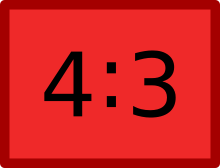
Back Format 4/3 French Layar penuh (rasio aspek) ID Fullscreen Italian フルスクリーン Japanese 1,33:1 LB 4:3 Dutch 4:3 Swedish 4:3 Ukrainian

Fullscreen (or full screen) refers to the 4:3 (1.3:1) aspect ratio of early standard television screens and computer monitors.[1] Widescreen ratios started to become more popular in the 1990s and 2000s.
Film originally created in the 4:3 aspect ratio does not need to be altered for full-screen release. In contrast, other aspect ratios can be converted to full screen using techniques such as pan and scan, open matte or reframing. In pan and scan, the 4:3 image is extracted from within the original frame by cropping the sides of the film. In open matte, the 4:3 image is extracted from parts of the original negative which were shot but not intended to be used for the theatrical release. In reframing, elements within the image are repositioned. Reframing is used for entirely CG movies, where the elements can be easily moved.[2][3]
- ^ Jim Taylor; Mark R. Johnson; Charles G. Crawford (2006). DVD Demystified. McGraw Hill Professional. ISBN 978-0-07-142398-4.
- ^ Joey Lott; Robert Reinhardt (11 April 2006). Flash 8 ActionScript Bible. John Wiley & Sons. pp. 789–. ISBN 978-0-471-79271-0.
- ^ Chris Jones (20 June 2003). Guerilla Film Makers Movie Blueprint. A&C Black. pp. 517–. ISBN 978-0-8264-1453-3.
© MMXXIII Rich X Search. We shall prevail. All rights reserved. Rich X Search